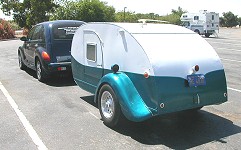I’ve read through some of the content here a while back, but not recently, so feel free to steer me to an existing thread if this has been covered before.
I’m getting into some of the details of my wiring system and spent some time this evening sketching out a wiring diagram for the 7-wire system on The Poet Creek Express. I'm contemplating an all 12vdc system with the only 120vac being an onboard battery tender with a simple pigtail shore power connection for easy battery maintenance while parked at home. We can always take advantage of hook-ups using a power strip and extension cord, but I don’t see us being ‘family resort’ style campers. No A/C or microwave. Not planning to need a heater. Some sort of roof fan, maybe supplemented by a muffin fan for low speed turnover of cabin air when cooling is not required.
I like this fuse panel from Blue Sea Systems.
Some of my lighting is shown in this post.
I’m considering having two deep cycle wet cell batteries for extended time between charging. Depending on weight balance, I am leaving it open as to location, galley or tongue box, or one in each.
Couple of questions:
1. With at least one, if not two house batteries on board, is there any legal requirement to have a dedicated breakaway battery for the brakes, as well? It seems kind of silly to have two separate batteries tied into the same ground and charging system, both in the tongue box, when one would do.
2. My tendency would be to have a chassis ground at each battery (or, if a dedicated breakaway battery is required, just one for the tongue box and another for the galley location). The brake solenoids and each of the trailer mounted marker lights would be grounded to the chassis, but all of the cabin, and galley light circuits would have wired ground paths back to the fuse panel, with the hatch mounted taillights having ground wires back to the trailer cord ground lead. Any concerns about conflicting ground paths with this arrangement?
3. How many circuits for the house/cabin? I plan on having 2 dome lights (one at the top of each side wall, each on their own wall switch) , courtesy/reading lights on each side, porch lights and foot lights on both sides of the cabin exterior (each side paired up on its own wall switch). A red 'night vision' light at the foot of the bed and a bar style light up on the galley hatch. All of these will be LED’s. A 12v power receptacle in the cabin like this, and maybe another in the galley. I may add a car stereo in the future.
My thoughts on the lights are that several can go on a circuit, but to spread them out a bit for redundancy. Perhaps feed the interior lights on one side of the cabin and the exterior lights on the other from one circuit; and the compliment from another; a separate circuit for the galley and night lights (with room to add task lights under the galley shelves if needed); separate circuits for each 12v outlet, a circuit for each fan, and one or two for the stereo. That’s nine (9) planned circuits with three (3) ‘extra’ spares.
4. Solar charging? Would be nice, but I don't think that the complexity, extra planning and expense makes sense for my needs. It would be nice on a long stay in the boonies (like Poet Creek) not to have to hook-up and run the TV to recharge. However, with two deep cycles, limited use of LED lights, and maybe charging a cell phone or note pad, I just might be able to go 5-6 days without discharging 50%, maybe. My guess is that any other trips will by hopscotching around, only staying in one place for a few days or so, so charging off of the TV will work great. The pros and cons of solar power have been discussed before, so don't feel like you need to discuss it again here. On one side of the coin there is the Slow Cowboy approach (which I am leaning toward) charging off of 7-way connector and TV alternator; on the other an expensive and somewhat complex system like Compass Rose and others (Boxcar, IIRC). The little portable panels seem like one more thing to pack, and to worry about while not in camp.
Any and all comments or suggestions are welcome…including suggestions to, “read the posts”.
Thanks.
(This post is also cross referenced in my build thread here.)
The Beginings Of A Plan - TPCE
5 posts
• Page 1 of 1
The Beginings Of A Plan - TPCE
KC
My Build: The Poet Creek Express Hybrid Foamie
Poet Creek Or Bust
Engineering the TLAR way - "That Looks About Right"
TnTTT ORIGINAL 200A LANTERN CLUB = "The 200A Gang"
Green Lantern Corpsmen
My Build: The Poet Creek Express Hybrid Foamie
Poet Creek Or Bust
Engineering the TLAR way - "That Looks About Right"
TnTTT ORIGINAL 200A LANTERN CLUB = "The 200A Gang"
Green Lantern Corpsmen
-

KCStudly - Donating Member
- Posts: 9640
- Images: 8169
- Joined: Mon Feb 06, 2012 10:18 pm
- Location: Southeastern CT, USA
Re: The Beginings Of A Plan - TPCE
I'd go with a more powerful battery tender. That way it could fully recharge a flat battery between weekends. The small ones are really only good for small batteries like standard car and motorcycle batteries. I abuse a couple 1.5 Amp ones by making them recharge old 110 Amp hour starting batteries for electric fence use. It takes a few days for a recharge from near fully discharged.
On power inlet, consider: http://www.amazon.com/gp/product/B000NV0V8C ParkPower by Marinco 150BBI.RV RV On-Board Charger Inlet (15-Amp, 125-Volt, Black). The inlet will get rid of the dangling plug tail. Either attach directly to your battery tender, or use a power strip in between.
The fuse panel is a good one. I've used circuit breaker switches instead, but it really is a matter of choice. In my 4Runner I set it up like a boat power panel. Each load is separately circuit breaker switched. I can then turn them on and off as needed and control power use that way. 12VDC and 120VAC each get their own panel. I just mounted my panels over a couple square junction boxes to house the wiring.
On power inlet, consider: http://www.amazon.com/gp/product/B000NV0V8C ParkPower by Marinco 150BBI.RV RV On-Board Charger Inlet (15-Amp, 125-Volt, Black). The inlet will get rid of the dangling plug tail. Either attach directly to your battery tender, or use a power strip in between.
The fuse panel is a good one. I've used circuit breaker switches instead, but it really is a matter of choice. In my 4Runner I set it up like a boat power panel. Each load is separately circuit breaker switched. I can then turn them on and off as needed and control power use that way. 12VDC and 120VAC each get their own panel. I just mounted my panels over a couple square junction boxes to house the wiring.
-

Bogo - 500 Club
- Posts: 658
- Images: 39
- Joined: Tue Oct 02, 2012 4:32 pm
- Location: The land between two rivers.
